碳纳米管材料的研究现状及发展展望[英文]
碳纳米管材料在生物医学领域的应用研究

碳纳米管材料在生物医学领域的应用研究在近些年的发展中,碳纳米管(Carbon nanotubes,简称CNTs)作为一种新材料,已经引起了生物医学领域的广泛关注。
由于其独特的结构和性能,碳纳米管材料被认为是一种极具应用潜力的新型生物医学材料。
本文将详细介绍碳纳米管材料在生物医学领域的研究现状和应用前景。
一、碳纳米管的特点和优势碳纳米管具有许多独特的物理和化学特性,从而使其在生物医学领域的应用变得日益重要。
首先,碳纳米管材料具有高度的化学稳定性,在生物体内具有显著的生物相容性和生物可降解性。
此外,碳纳米管的表面能很容易地修饰,可以实现与生物分子的特异性结合,例如靶向治疗,生物检测和成像等方面提供了重要优势。
另外,碳纳米管还具有很高的导电性和导热性,可以实现电刺激和热疗方面的应用。
总之,碳纳米管作为一种优秀的生物医学材料,具有很多的潜在应用和研究价值。
二、碳纳米管在生物医学领域的应用1. 生物分子检测和诊断碳纳米管具有很高的表面积和活性,可以在其表面修饰生物分子,实现对生物分子的高灵敏检测,例如DNA,RNA和蛋白质等。
同时,由于碳纳米管的电化学性能优异,可以实现生物分子的电化学检测,是一种新型的生物分子检测技术。
此外,碳纳米管还可以通过变形性表面等特征来检测生物分子,这为诊断和治疗提供了极大的便利。
2. 组织工程和再生医学碳纳米管的生物相容性良好,可以用于大量组织和生物医学工程的应用,例如组织修复和再生医学。
碳纳米管可以作为组织材料的骨骼和骨架,支持组织生长和再生医学的应用。
碳纳米管还可以被用作组织机械加固剂,用于骨折和组织缺损的治疗。
此外,在神经科学领域,碳纳米管还可以用作神经元生长的引导和神经再生的促进。
3. 药物传输系统碳纳米管可以在其表面修饰药物分子,实现针对性药物传输。
此外,碳纳米管还可以通过电磁刺激、热疗等方式实现药物的释放。
碳纳米管材料的表面积大,可以搭载大量的药物分子,而后通过局部或全局施加刺激,实现药物释放的可控性,为临床药物治疗提供了新的思路。
Carbon Nanotube Electronics

Carbon Nanotube Electronics随着科学和技术的发展,人类不断探索新型材料在各个领域的应用。
碳纳米管(Carbon Nanotube)作为一种新型材料,由于其独特的性质在电子学领域中引起了广泛的关注和研究。
本文将探讨碳纳米管电子学的背景、特性、应用及未来发展趋势。
一、背景碳纳米管是由碳原子构成的一种纳米材料,其通过一定的方法制备出来。
1985年,日本学者Sumio Lijima在石墨电极上运用扫描电子显微镜首次观察到了碳纳米管。
随后,人们开始研究碳纳米管的性质和应用,绿色、良好的弹性和导电性质使得碳纳米管很快成为了研究对象。
被证明,碳纳米管具有比铜更高的电导率和更好的导电性能,而且由于其尺寸纳米级别,因此也具有良好的柔性和弹性。
二、特性1.导电性能好:由于碳纳米管是碳原子不断连接形成的一根管子,因此它具有非常好的导电性能。
导电性能优于其他材料,特别是在小型电子学器件中发挥着重要的作用。
2.热稳定性好:碳纳米管可以抵抗高温,这是由于碳纳米管的化学结构带有高度的稳定性而造成的。
3.柔性和弹性好:由于碳纳米管的尺寸只有纳米级别,因此它具有良好的柔性和弹性。
这使得碳纳米管成为了可弯曲电子学器件中的重要材料。
4.光学性能好:碳纳米管具有很好的光学特性,这意味着它可以广泛应用于纳米涂层和纳米光学元件等领域。
5.化学性能好:碳纳米管具有良好的化学性能,因此它是许多化学领域中的重要材料。
三、应用1.电子学器件:由于碳纳米管具有优良的导电性能,可作为半导体材料的碳纳米管晶体管,因其体积小、速度快、功耗低等优点正逐渐取代传统的电子器件。
2.柔性触摸屏:由于碳纳米管的柔性和弹性,它可以用于制造柔性触摸屏,相比于传统的触摸屏,和柔性电路板,碳纳米管有更好的抗冲击性和集成性能。
3.柔性电子学器件:碳纳米管柔性电子学器件具有独特的功能,如热稳定性好、高强度、弯曲柔性、低功耗等,它们可用于制造旗帜、面罩等物品,以便在各种形状和表面上显示信息。
碳纳米管材料的研究及其应用前景

碳纳米管材料的研究及其应用前景碳纳米管(Carbon nanotubes,CNTs)是由碳原子组成的一种空心管状结构材料,具有极高的强度、导电性和导热性。
由于它独特的物理和化学特性,自其发现以来,研究人员不断探索其广泛的应用前景。
本文将介绍碳纳米管材料的基本特性、制备方法以及其在电子、能源、生物医学和环境保护等领域的应用前景。
一、碳纳米管材料的基本特性碳纳米管具有以下几种基本特性:1.直径十分微小:CNTs的直径在1~100纳米之间。
这使得CNTs具有很高的比表面积,能够增加与其他材料的接触面积。
2.极高的强度:CNTs的强度是其他材料的1~10倍,而重量却非常轻。
3.优异的导电性:CNTs的电阻率约为铜的1/10,可作为电子器件的理想材料。
4.高导热性:CNTs的导热性是铜的1.5倍。
5.化学惰性:由于碳的化学惰性,CNTs对大多数化学物质的影响较小,有利于其应用。
二、碳纳米管制备方法CNTs的制备方法种类繁多。
下面我们介绍几种典型的制备方法。
1.化学气相沉积法(CVD法)CVD法是一种通过气相物质反应制备CNTs的方法。
其基本原理是将碳源物质在高温下分解,使碳原子与金属催化剂相互作用生成碳纳米管。
CVD法是制备CNTs最优秀、最经济、最可定向的方法之一。
2.电弧放电法电弧放电法是一种利用碳棒电弧在惰性气氛中蒸发和冷凝的方法。
利用惰性气氛,如氦、氩、氮和氩氮混合气体等,在自由场内放电形成高温、高压电弧,产生不同形态(单壁、多壁)的CNTs。
3.化学还原法化学还原法通常使用碳酸钠和其他金属盐作为原料。
其基本原理是将金属离子还原为纳米金属,并使金属与碳源分解并生成CNTs。
化学还原法通常需要很长的反应时间,往往需要在高温条件下完成。
三、碳纳米管的应用前景1.电子学领域CNTs的高导电性和微小的直径使之成为微处理器中理想的电路元件。
CNTs的高速传输和强度也为光电晶体管、电晕放电、场发射和纳米电子器件提供了非常好的材料基础。
碳纳米管的研究及展望
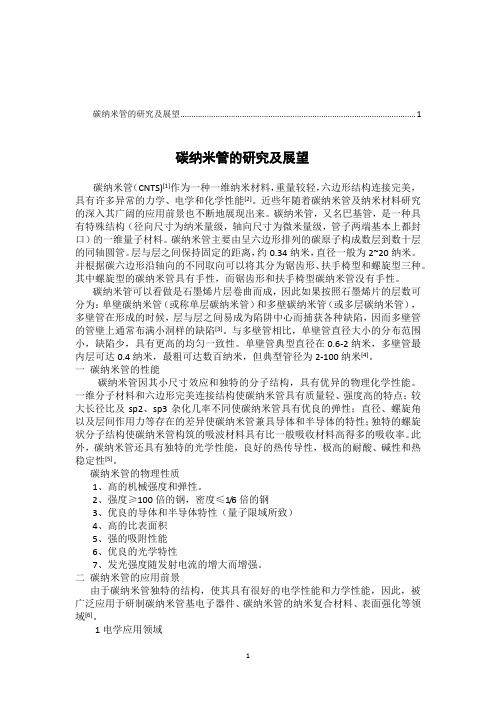
碳纳米管的研究及展望 (1)碳纳米管的研究及展望碳纳米管(CNTS)[1]作为一种一维纳米材料,重量较轻,六边形结构连接完美,具有许多异常的力学、电学和化学性能[2]。
近些年随着碳纳米管及纳米材料研究的深入其广阔的应用前景也不断地展现出来。
碳纳米管,又名巴基管,是一种具有特殊结构(径向尺寸为纳米量级,轴向尺寸为微米量级,管子两端基本上都封口)的一维量子材料。
碳纳米管主要由呈六边形排列的碳原子构成数层到数十层的同轴圆管。
层与层之间保持固定的距离,约0.34纳米,直径一般为2~20纳米。
并根据碳六边形沿轴向的不同取向可以将其分为锯齿形、扶手椅型和螺旋型三种。
其中螺旋型的碳纳米管具有手性,而锯齿形和扶手椅型碳纳米管没有手性。
碳纳米管可以看做是石墨烯片层卷曲而成,因此如果按照石墨烯片的层数可分为:单壁碳纳米管(或称单层碳纳米管)和多壁碳纳米管(或多层碳纳米管),多壁管在形成的时候,层与层之间易成为陷阱中心而捕获各种缺陷,因而多壁管的管壁上通常布满小洞样的缺陷[3]。
与多壁管相比,单壁管直径大小的分布范围小,缺陷少,具有更高的均匀一致性。
单壁管典型直径在0.6-2纳米,多壁管最内层可达0.4纳米,最粗可达数百纳米,但典型管径为2-100纳米[4]。
一碳纳米管的性能碳纳米管因其小尺寸效应和独特的分子结构,具有优异的物理化学性能。
一维分子材料和六边形完美连接结构使碳纳米管具有质量轻、强度高的特点;较大长径比及sp2、sp3杂化几率不同使碳纳米管具有优良的弹性;直径、螺旋角以及层间作用力等存在的差异使碳纳米管兼具导体和半导体的特性;独特的螺旋状分子结构使碳纳米管构筑的吸波材料具有比一般吸收材料高得多的吸收率。
此外,碳纳米管还具有独特的光学性能,良好的热传导性,极高的耐酸、碱性和热稳定性[5]。
碳纳米管的物理性质1、高的机械强度和弹性。
2、强度≥100倍的钢,密度≤1/6倍的钢3、优良的导体和半导体特性(量子限域所致)4、高的比表面积5、强的吸附性能6、优良的光学特性7、发光强度随发射电流的增大而增强。
碳纳米管聚合物基复合材料力学性能研究及应用前景
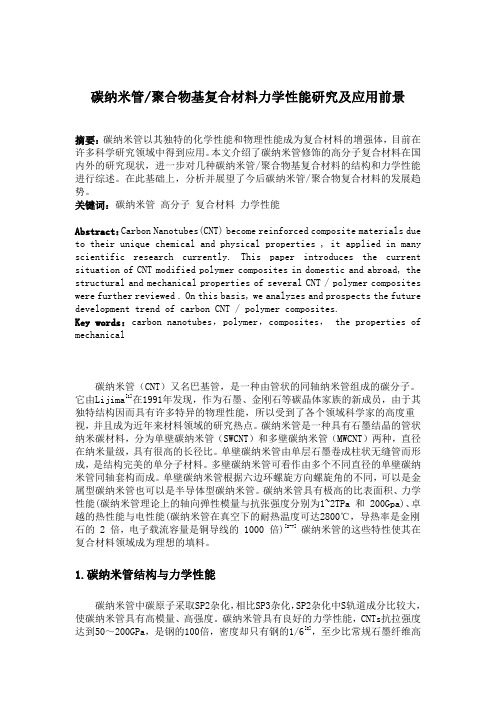
碳纳米管/聚合物基复合材料力学性能研究及应用前景摘要:碳纳米管以其独特的化学性能和物理性能成为复合材料的增强体,目前在许多科学研究领域中得到应用。
本文介绍了碳纳米管修饰的高分子复合材料在国内外的研究现状,进一步对几种碳纳米管/聚合物基复合材料的结构和力学性能进行综述。
在此基础上,分析并展望了今后碳纳米管/聚合物复合材料的发展趋势。
关键词:碳纳米管高分子复合材料力学性能Abstract:Carbon Nanotubes(CNT) become reinforced composite materials due to their unique chemical and physical properties , it applied in many scientific research currently. This paper introduces the current situation of CNT modified polymer composites in domestic and abroad, the structural and mechanical properties of several CNT / polymer composites were further reviewed . On this basis, we analyzes and prospects the future development trend of carbon CNT / polymer composites.Key words:carbon nanotubes,polymer,composites, the properties of mechanical碳纳米管(CNT)又名巴基管,是一种由管状的同轴纳米管组成的碳分子。
它由Lijima[1]在1991年发现,作为石墨、金刚石等碳晶体家族的新成员,由于其独特结构因而具有许多特异的物理性能,所以受到了各个领域科学家的高度重视,并且成为近年来材料领域的研究热点。
国外碳纳米管复合材料研究现状
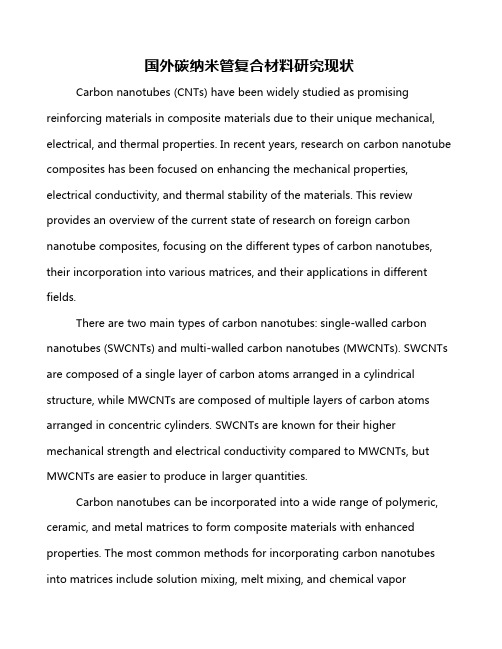
国外碳纳米管复合材料研究现状Carbon nanotubes (CNTs) have been widely studied as promising reinforcing materials in composite materials due to their unique mechanical, electrical, and thermal properties. In recent years, research on carbon nanotube composites has been focused on enhancing the mechanical properties, electrical conductivity, and thermal stability of the materials. This review provides an overview of the current state of research on foreign carbon nanotube composites, focusing on the different types of carbon nanotubes, their incorporation into various matrices, and their applications in different fields.There are two main types of carbon nanotubes: single-walled carbon nanotubes (SWCNTs) and multi-walled carbon nanotubes (MWCNTs). SWCNTs are composed of a single layer of carbon atoms arranged in a cylindrical structure, while MWCNTs are composed of multiple layers of carbon atoms arranged in concentric cylinders. SWCNTs are known for their higher mechanical strength and electrical conductivity compared to MWCNTs, but MWCNTs are easier to produce in larger quantities.Carbon nanotubes can be incorporated into a wide range of polymeric, ceramic, and metal matrices to form composite materials with enhanced properties. The most common methods for incorporating carbon nanotubes into matrices include solution mixing, melt mixing, and chemical vapordeposition. The choice of matrix material and processing method can greatly affect the properties of the resulting composite material.One of the key advantages of carbon nanotube composites is their exceptional mechanical properties. The high aspect ratio and strong covalent bonds of carbon nanotubes make them ideal reinforcing materials for improving the strength and stiffness of composite materials. Studies have shown that the addition of carbon nanotubes can significantly increase the tensile strength, flexural strength, and impact resistance of composite materials. Additionally, carbon nanotubes can also improve the toughness and fatigue resistance of composite materials, making them suitable for a wide range of structural applications.In addition to their mechanical properties, carbon nanotube composites are also known for their excellent electrical conductivity. Carbon nanotubes have a high electrical conducti vity due to their delocalized π-electron system, making them ideal materials for applications in electronics, sensors, and energy storage devices. Studies have shown that the addition of carbon nanotubes can significantly increase the electrical conductivity of composite materials, making them suitable for use in conductive coatings, electromagnetic shielding, and antistatic materials.Furthermore, carbon nanotube composites also exhibit enhanced thermal stability due to the excellent thermal conductivity of carbon nanotubes. Thehigh thermal conductivity of carbon nanotubes allows for efficient heat transfer within the composite material, leading to improved thermal management and heat dissipation properties. Studies have shown that the addition of carbon nanotubes can significantly increase the thermal conductivity and heat resistance of composite materials, making them suitable for applications in aerospace, automotive, and electronic devices.Overall, research on foreign carbon nanotube composites has shown promising results in enhancing the mechanical, electrical, and thermal properties of composite materials. The unique properties of carbon nanotubes make them ideal reinforcing materials for improving the performance of composite materials in various applications. Further research is needed to optimize the processing methods and matrix materials to fully exploit the potential of carbon nanotube composites in different fields.。
2024年碳纳米管市场分析现状
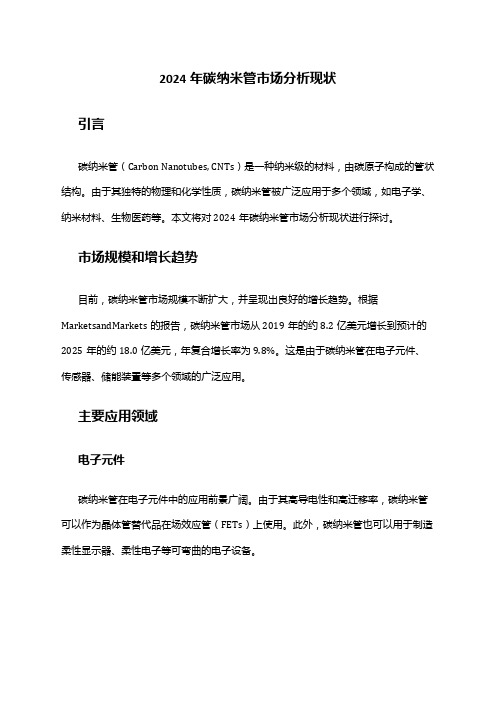
2024年碳纳米管市场分析现状引言碳纳米管(Carbon Nanotubes, CNTs)是一种纳米级的材料,由碳原子构成的管状结构。
由于其独特的物理和化学性质,碳纳米管被广泛应用于多个领域,如电子学、纳米材料、生物医药等。
本文将对2024年碳纳米管市场分析现状进行探讨。
市场规模和增长趋势目前,碳纳米管市场规模不断扩大,并呈现出良好的增长趋势。
根据MarketsandMarkets的报告,碳纳米管市场从2019年的约8.2亿美元增长到预计的2025年的约18.0亿美元,年复合增长率为9.8%。
这是由于碳纳米管在电子元件、传感器、储能装置等多个领域的广泛应用。
主要应用领域电子元件碳纳米管在电子元件中的应用前景广阔。
由于其高导电性和高迁移率,碳纳米管可以作为晶体管替代品在场效应管(FETs)上使用。
此外,碳纳米管也可以用于制造柔性显示器、柔性电子等可弯曲的电子设备。
碳纳米管的高灵敏度和高选择性使其成为理想的传感器材料。
它可以用于气体传感器、压力传感器、湿度传感器等多个领域。
此外,由于其独特的电化学性质,碳纳米管还可以用于生物传感器的制备。
储能装置碳纳米管具有高比表面积和优异的导电性能,这使其成为理想的储能材料。
碳纳米管可以用于超级电容器和锂离子电池等储能装置的制备。
它可以显著提高储能装置的能量密度和循环寿命。
纳米材料碳纳米管还可以应用于纳米复合材料的制备。
通过将碳纳米管与其他材料进行复合,可以制备出具有高强度、高导电性、高热导率等优异性能的材料。
这种材料可以应用于航空航天、汽车、建筑等多个领域。
主要市场参与者华东地区华东地区作为中国碳纳米管产业的主要地区,有许多重要的碳纳米管制造企业,如南京纳米技术研究所、苏州纳米技术研究所等。
这些企业在碳纳米管的制备、应用研究等方面具有一定的优势。
美国在碳纳米管市场中处于领先地位。
众多创新型企业和研究机构,如Nanocyl、ARKEMA等,在碳纳米管的研发和生产方面具有较强的实力和经验。
碳纳米管的研究和发展

碳纳米管的研究和发展碳纳米管 (Carbon nanotube,CNT) 是一种由碳原子形成的长管状结构。
这种材料因其独特的物理特性而备受关注,尤其在微纳电子领域,因为其尺寸相当于实际晶体管器件的尺寸,因此很有可能成为下一代集成电路的基础材料之一。
碳纳米管的基本结构是一个由六个碳原子组成的蜂窝状六角形结构,这种结构的单元堆积起来形成纤维状、管状或球状的结构。
正因为其结构的独特性,碳纳米管同其他材料相比有诸多优点。
首先,碳纳米管的强度非常高,比钢铁强度还要高出100倍以上。
其次,碳纳米管的导电性能更是远高于同样粗细的导线,是电子领域新型纳米电子器件的重要研究对象。
同时,碳纳米管也具有高度的柔韧性和可塑性,在材料设计和制备方面也有很大的前景。
如今,碳纳米管已经成为了材料科学领域广泛研究的热点,其在石墨烯、柔性电子、纳米电子器件等领域都有不可替代的作用。
在这些应用方面,碳纳米管的制备和控制所面临的挑战也越来越大。
在碳纳米管制备技术方面,化学气相沉积 (CVD) 技术已成为了一种主要的碳纳米管制备方法之一。
该技术通过将金属催化剂 (如铁、镍、钴等) 与碳源混合在一起,然后通过加热创造一定的反应环境,促使碳源中的碳分子在催化剂表面纵向生长形成碳纳米管。
但另一方面,制备好的碳纳米管往往存在掺杂不纯的问题,如金属、氧化物等的不纯物质在制备过程中混入可能会影响其电子传输性能。
在控制碳纳米管结构方面,目前也已经有了很多进展。
在团队合作的研究中,研究人员们利用高温燃烧的方法,可以将直径不同的一连串管子“张开”,并拼成复合材料,这种方法使得碳纳米管的结构得到了更好的控制。
同时,通过改变碳纳米管管道内腔的现有设计,研究人员也希望能够改变其电导特性,或者增强其材料柔韧性。
在未来几年里,碳纳米管的制造和应用技术将会继续推进,并引发新一轮科技革命。
同时,随着碳纳米管研究的深入,相信人们会逐渐发现更多它的可能性和潜力,让我们拭目以待。
碳纳米管的研究与应用前景

碳纳米管的研究与应用前景碳纳米管(Carbon Nanotubes,CNTs)是由碳原子组成的一种纳米材料,具有独特的结构和优异的性能,因此在科学研究和应用领域具有广阔的前景。
本文将探讨碳纳米管的研究进展和应用前景。
首先,碳纳米管具有优异的力学性能。
由于其高度有序的原子结构,碳纳米管具有卓越的机械强度和刚度。
研究者已经成功地制备了具有纤维状结构的碳纳米管,这些纤维可以用来制造强度超过钢材的高性能复合材料。
此外,碳纳米管还具有良好的柔韧性和弹性,因此可以用于制造高强度的纺织品、防弹材料和抗摩擦涂层等。
其次,碳纳米管具有出色的导电和导热性能。
由于碳纳米管中的电子能量带结构独特,使得导电性能非常优异。
此外,碳纳米管的热导率也非常高,远高于其他材料。
因此,碳纳米管可以用于制造高性能的导电器件,如高速晶体管、纳米传感器和电子设备等。
此外,碳纳米管还具有优异的化学稳定性和生物相容性。
由于碳原子的结构稳定,碳纳米管在高温、酸碱等极端环境下具有良好的稳定性。
因此,碳纳米管可以应用于催化剂、膜材料和能源存储等领域。
另外,由于碳纳米管的尺寸尺度与生物分子相近,因此具有良好的生物相容性。
研究人员已经成功地将碳纳米管应用于生物成像、药物载体和生物传感器等领域。
此外,碳纳米管还具有其他独特的性能和应用前景。
例如,碳纳米管具有光学特性,可以发射和吸收可见光和紫外光,因此可以被应用于光电器件、太阳能电池和显示技术等。
此外,碳纳米管还具有独特的气体分子吸附能力,可以用于气体传感器和气体分离等领域。
同时,碳纳米管还可以通过掺杂和功能化改善其性能,如掺杂硼、硅等原子可以调控碳纳米管的导电性能。
然而,碳纳米管的研究和应用仍面临一些挑战。
首先,大规模制备碳纳米管的方法仍然不够成熟和经济效益。
其次,碳纳米管的定量检测和表征仍然比较困难,需要开发更准确、高效的实验方法。
此外,碳纳米管的毒性和环境影响也需要深入研究和评估。
总之,碳纳米管作为一种新型纳米材料,具有独特的结构和优异的性能,因此在科学研究和应用领域具有广泛的前景。
2023年碳纳米管(CNT)行业市场分析现状
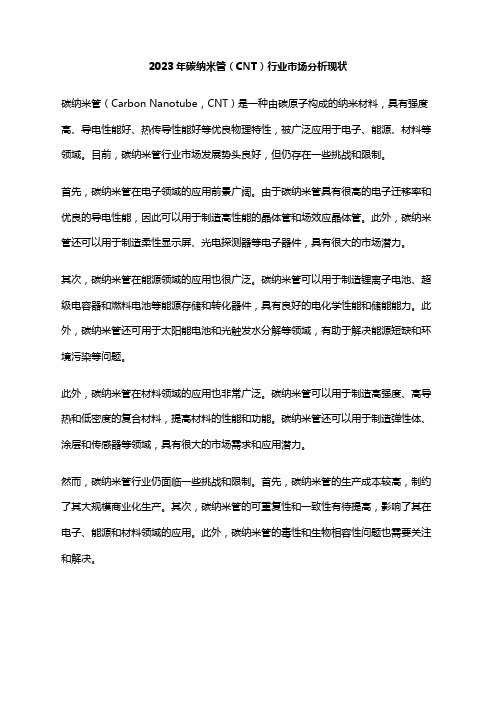
2023年碳纳米管(CNT)行业市场分析现状碳纳米管(Carbon Nanotube,CNT)是一种由碳原子构成的纳米材料,具有强度高、导电性能好、热传导性能好等优良物理特性,被广泛应用于电子、能源、材料等领域。
目前,碳纳米管行业市场发展势头良好,但仍存在一些挑战和限制。
首先,碳纳米管在电子领域的应用前景广阔。
由于碳纳米管具有很高的电子迁移率和优良的导电性能,因此可以用于制造高性能的晶体管和场效应晶体管。
此外,碳纳米管还可以用于制造柔性显示屏、光电探测器等电子器件,具有很大的市场潜力。
其次,碳纳米管在能源领域的应用也很广泛。
碳纳米管可以用于制造锂离子电池、超级电容器和燃料电池等能源存储和转化器件,具有良好的电化学性能和储能能力。
此外,碳纳米管还可用于太阳能电池和光触发水分解等领域,有助于解决能源短缺和环境污染等问题。
此外,碳纳米管在材料领域的应用也非常广泛。
碳纳米管可以用于制造高强度、高导热和低密度的复合材料,提高材料的性能和功能。
碳纳米管还可以用于制造弹性体、涂层和传感器等领域,具有很大的市场需求和应用潜力。
然而,碳纳米管行业仍面临一些挑战和限制。
首先,碳纳米管的生产成本较高,制约了其大规模商业化生产。
其次,碳纳米管的可重复性和一致性有待提高,影响了其在电子、能源和材料领域的应用。
此外,碳纳米管的毒性和生物相容性问题也需要关注和解决。
总的来说,碳纳米管行业市场发展势头良好,具有广阔的应用前景和市场潜力。
随着技术的不断突破和成熟,碳纳米管有望在电子、能源和材料等领域发挥更大的作用。
然而,碳纳米管行业仍需要解决一些挑战和限制,以进一步推动市场发展和应用推广。
碳纳米管技术的研究现状和应用

碳纳米管技术的研究现状和应用碳纳米管技术的研究现状及应用自1991年发现碳纳米管(Carbon nanotubes,简称CNTs)以来,该领域一直备受关注。
The structure of CNTs is unique, which consists of a tube-like form with a diameter of few nanometers and an extremely high aspect ratio. The study of CNTs has breakthroughs in diverse fields, including energy storage, electronics, materials science, drug delivery and biosensors.首先,碳纳米管在能源存储领域。
碳纳米管具有良好的导电性,可用于制造高性能电池。
此外,CNT材料具有高比表面积和优异的电容性能,可用于超级电容器和电化学传感器。
一项研究表明,添加CNTs到电极材料中将大大提高电池的能量密度和功率密度。
这项技术使得电动汽车,手机和其他电池供电设备的效率和性能得到提升。
其次,碳纳米管在电子学领域。
CNTs是单壁碳纳米管,它们作为另一种半导体材料有着广泛的应用。
单壁CNTs被认为是绝缘材料和导体之间的理想过渡。
它们还可用于有机薄膜晶体管的制造,可提供超快速的开/关导电效果。
此外,CNTs也适用于光电子学和量子计算。
第三,碳纳米管在材料科学中的应用。
CNTs由于其高比表面积和低密度,具有高强度,高刚性和高可塑性的优异性能。
它们可用于多种应用,如制造轻质材料,高强度复合材料,导热材料和防腐蚀涂层等。
一项研究表明,CNT 复合材料更适用于自然灾害后的修复和重建任务,可大大降低维护成本。
第四,碳纳米管在医疗应用中的潜力。
CNTs具有很强的机械刚度和导电特性,这些特性使得它们成为极有前途的生物医学工程材料。
2024年碳纳米管导电浆料市场发展现状

2024年碳纳米管导电浆料市场发展现状概述碳纳米管(Carbon Nanotubes,CNTs)是一种具有优异导电性能、独特物理化学性质的新型纳米材料。
碳纳米管导电浆料是一种将碳纳米管作为主体材料,与其他成分混合形成的浆料。
在电子、电池、传感器等领域中,碳纳米管导电浆料具有广阔的应用前景,并呈现出快速发展的趋势。
市场规模据市场研究和预测机构的数据显示,碳纳米管导电浆料市场正处于快速增长阶段。
预计在未来几年内,碳纳米管导电浆料市场的年复合增长率将保持在较高水平。
市场规模也将逐步扩大,成为纳米材料市场的重要组成部分。
应用领域电子行业碳纳米管导电浆料在电子行业中具有广泛的应用。
碳纳米管导电浆料可以用于制造高性能的导电膜,包括柔性导电膜、透明导电膜等。
这些导电膜可应用于显示屏、触摸屏、导电笔等电子产品中,提升其导电性能和可靠性。
电池领域在新能源电池领域,碳纳米管导电浆料也具有重要的应用价值。
碳纳米管导电浆料可以作为电池电极材料的添加剂,提高电池的导电性能和循环稳定性。
此外,碳纳米管导电浆料还可以用于制造超级电容器,具有高能量密度和长寿命等优势。
传感器领域碳纳米管导电浆料在传感器领域中也有广泛的应用。
由于其高导电性和灵敏度,碳纳米管导电浆料可以作为传感器的敏感层,用于检测和测量各种物理和化学参数。
如压力传感器、温度传感器、气体传感器等。
技术进展随着碳纳米管导电浆料市场的不断发展,相关技术也在不断突破和改进。
目前,一些新型的制备方法和改良技术被广泛应用于碳纳米管导电浆料的生产与加工过程中,进一步提高了碳纳米管导电浆料的质量和性能。
市场竞争碳纳米管导电浆料市场存在着竞争激烈的局面。
目前,市场上有多家厂商提供碳纳米管导电浆料产品。
这些厂商主要通过提高产品质量、降低成本、增加研发投入等手段来增强自身的竞争力。
此外,一些新进入市场的公司也在加快研发步伐,努力推出更具竞争力的产品。
市场前景碳纳米管导电浆料市场具有广阔的发展前景和巨大的商业价值。
碳纳米管导电剂行业市场现状分析及未来三到五年发展趋势报告

碳纳米管导电剂行业市场现状分析及未来三到五年发展趋势报告Carbon Nanotube Conductive Agent Industry Market Status Analysis and Future Development Trend ReportIntroduction:Carbon nanotubes (CNTs) are one of the most promising materials in the field of nanotechnology due to their unique electrical, mechanical and thermal properties. CNT conductive agents have been widely used in various fields such as electronics, energy, aerospace and biomedicine. This report aims to analyze the current market status of CNT conductive agents and predict the future development trends for the next three to five years.Market Status Analysis:The CNT conductive agent industry has experienced rapid growth in recent years. In 2019, the global market size of CNT conductive agents was approximately USD 200 million and is expected to reach USD 500 million by 2025, with a CAGR of 15. The electronics industry is the largest application field ofCNT conductive agents, accounting for more than 60 of the market share. With the development of wearable devices and the Internet of Things, the demand for flexible and transparent conductive materials has increased, which has greatly promoted the application of CNT conductive agents in the field of electronics.The energy industry is another important application field of CNT conductive agents. CNT conductive agents can effectively improve the performance of energy storage devices such as lithium-ion batteries and supercapacitors. In addition, CNT conductive agents can also be used as conductive fillers in conductive pastes for solar cells, which can greatly improve the conversion efficiency of solar cells.The aerospace industry is also a potential application field of CNT conductive agents. CNT conductive agents can be used as conductive coatings for aircraft and spacecraft, which can effectively improve the electromagnetic shielding performance and reduce the weight of the equipment.Future Development Trends:The development of CNT conductive agents in the future will mainly focus on the following aspects:1. Cost Reduction: The high cost of CNT conductive agents has been a major obstacle to their large-scale application. In the future, the development of low-cost production processes and the improvement of production efficiency will be the focus of research and development.2. Application Expansion: In addition to the electronics, energy and aerospace industries, the application of CNT conductive agents in other fields such as biomedicine, sensors and catalysis will also be explored.3. Performance Improvement: The improvement of the electrical conductivity, thermal conductivity and mechanical properties of CNT conductive agents will be the focus of research and development, which will further expand their application scope and improve their performance in existing application fields.结语:碳纳米管导电剂是一种非常有前途的新材料,具有独特的电学、机械和热学性质。
碳纳米管技术的发展现状及应用前景分析
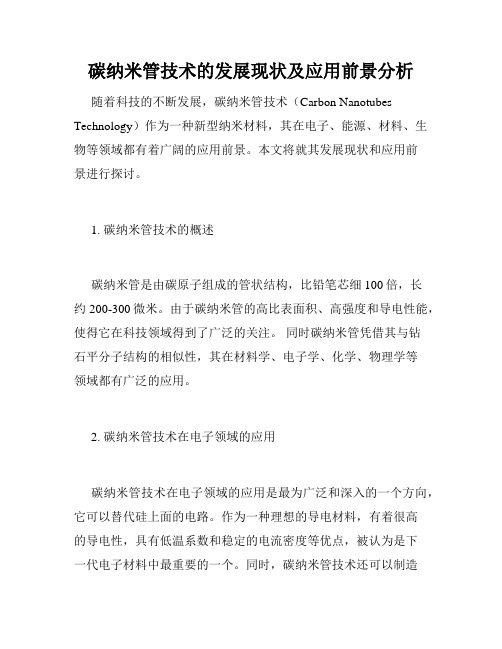
碳纳米管技术的发展现状及应用前景分析随着科技的不断发展,碳纳米管技术(Carbon Nanotubes Technology)作为一种新型纳米材料,其在电子、能源、材料、生物等领域都有着广阔的应用前景。
本文将就其发展现状和应用前景进行探讨。
1. 碳纳米管技术的概述碳纳米管是由碳原子组成的管状结构,比铅笔芯细100倍,长约200-300微米。
由于碳纳米管的高比表面积、高强度和导电性能,使得它在科技领域得到了广泛的关注。
同时碳纳米管凭借其与钻石平分子结构的相似性,其在材料学、电子学、化学、物理学等领域都有广泛的应用。
2. 碳纳米管技术在电子领域的应用碳纳米管技术在电子领域的应用是最为广泛和深入的一个方向,它可以替代硅上面的电路。
作为一种理想的导电材料,有着很高的导电性,具有低温系数和稳定的电流密度等优点,被认为是下一代电子材料中最重要的一个。
同时,碳纳米管技术还可以制造更高效的半导体芯片,这将极大地推动芯片技术进一步提升,以及为新一代电脑、手机设备等提供更好的性能,更低的能耗和更小的面积。
3. 碳纳米管技术在能源领域的应用碳纳米管在能源领域的应用主要是利用其高导电和高效电化学反应的特性来制造更高效和便携的储能设备。
目前碳纳米管技术在锂离子电池和超级电容器领域得到了广泛的应用。
例如,碳纳米管电极在电池中的使用,既可以改善电化学反应速度,增加电池存储能量密度,又可以将它应用在电解液和界面层。
4. 碳纳米管技术在材料领域的应用碳纳米管具有高强度、高韧性、高模量等优异性能,使它适用于复杂材料和结构的构造。
因此,碳纳米管在材料领域的应用非常广泛,它可以用于制造高强度的纤维,增强陶瓷、塑料和复合材料的韧性和强度,还可以用于制造防弹衣、航空材料等。
5. 碳纳米管技术在生物领域的应用在生物领域,碳纳米管也被广泛应用于医疗和生命科学领域。
它可以做为制药和诊断试剂使用,并且可以在生物组织中轻松地渗透和输送(携带)药物,这使得医疗领域可以更好的控制药物的药效和药代谢,达到更好的治疗效果。
2024年碳纳米管市场前景分析
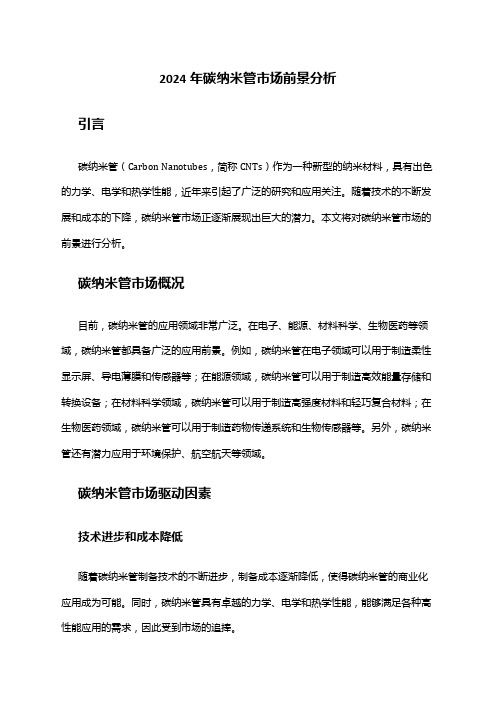
2024年碳纳米管市场前景分析引言碳纳米管(Carbon Nanotubes,简称CNTs)作为一种新型的纳米材料,具有出色的力学、电学和热学性能,近年来引起了广泛的研究和应用关注。
随着技术的不断发展和成本的下降,碳纳米管市场正逐渐展现出巨大的潜力。
本文将对碳纳米管市场的前景进行分析。
碳纳米管市场概况目前,碳纳米管的应用领域非常广泛。
在电子、能源、材料科学、生物医药等领域,碳纳米管都具备广泛的应用前景。
例如,碳纳米管在电子领域可以用于制造柔性显示屏、导电薄膜和传感器等;在能源领域,碳纳米管可以用于制造高效能量存储和转换设备;在材料科学领域,碳纳米管可以用于制造高强度材料和轻巧复合材料;在生物医药领域,碳纳米管可以用于制造药物传递系统和生物传感器等。
另外,碳纳米管还有潜力应用于环境保护、航空航天等领域。
碳纳米管市场驱动因素技术进步和成本降低随着碳纳米管制备技术的不断进步,制备成本逐渐降低,使得碳纳米管的商业化应用成为可能。
同时,碳纳米管具有卓越的力学、电学和热学性能,能够满足各种高性能应用的需求,因此受到市场的追捧。
应用需求增加随着电子行业的不断发展和智能化产品的普及,对于高性能材料的需求也越来越大。
碳纳米管作为一种新型的纳米材料,能够满足高性能材料的需求,因此在电子行业中具有广阔的市场潜力。
另外,碳纳米管在能源、材料科学和生物医药等领域的应用需求也在不断增加。
环境和能源问题随着环境污染和能源短缺问题的日益严重,碳纳米管作为一种绿色、高效的材料,可以应用于环境保护和新能源领域,具有巨大的市场潜力。
碳纳米管市场的挑战制备技术和质量控制目前,碳纳米管的制备技术和质量控制仍然存在一定的挑战。
碳纳米管的纯度、长度和直径都对其性能和应用产生重要影响,因此需要研发更加成熟的制备技术和精确的质量控制方法。
产能和成本问题目前,碳纳米管的产能仍然相对较低,无法满足大规模商业化应用的需求。
同时,碳纳米管的制备成本也相对较高,需要进一步降低成本才能推动其商业化应用。
国外碳纳米管复合材料研究现状
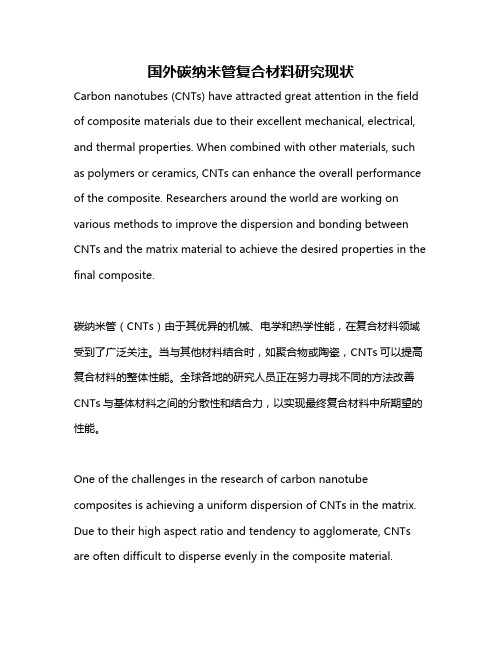
国外碳纳米管复合材料研究现状Carbon nanotubes (CNTs) have attracted great attention in the field of composite materials due to their excellent mechanical, electrical, and thermal properties. When combined with other materials, such as polymers or ceramics, CNTs can enhance the overall performance of the composite. Researchers around the world are working on various methods to improve the dispersion and bonding between CNTs and the matrix material to achieve the desired properties in the final composite.碳纳米管(CNTs)由于其优异的机械、电学和热学性能,在复合材料领域受到了广泛关注。
当与其他材料结合时,如聚合物或陶瓷,CNTs可以提高复合材料的整体性能。
全球各地的研究人员正在努力寻找不同的方法改善CNTs与基体材料之间的分散性和结合力,以实现最终复合材料中所期望的性能。
One of the challenges in the research of carbon nanotube composites is achieving a uniform dispersion of CNTs in the matrix. Due to their high aspect ratio and tendency to agglomerate, CNTs are often difficult to disperse evenly in the composite material.Improper dispersion can lead to weak interfacial bonding, which limits the enhancement of mechanical properties. Various techniques, such as functionalization of CNTs or the use of surfactants, have been explored to improve dispersion and enhance the overall performance of the composite.碳纳米管复合材料研究中的一个挑战是实现CNTs在基体中的均匀分散。
2024年碳纳米管(CNT)市场前景分析

2024年碳纳米管(CNT)市场前景分析引言碳纳米管(Carbon Nanotubes, CNT)作为一种新兴的纳米材料,在过去几十年中引起了广泛的关注。
其独特的性质和广泛的应用前景,使得碳纳米管在众多领域中成为研究的热点。
本文将对碳纳米管的市场前景进行分析,并探讨其在未来的发展潜力。
碳纳米管的基本特性碳纳米管是由碳原子构成的纳米管状结构,具有以下基本特性:1.高强度和刚度:碳纳米管比钢材还要强硬,是已知最强的材料之一。
2.优异的导电性:碳纳米管具有优秀的导电性能,可应用于电子器件领域。
3.良好的热导性:碳纳米管具有良好的热导性能,可以用于制备高效的散热材料。
4.巨大的比表面积:碳纳米管具有巨大的比表面积,可应用于催化剂和吸附材料等领域。
碳纳米管市场应用前景1. 电子器件碳纳米管具有优异的导电性能,可以用于制造高性能的电子器件。
例如,碳纳米管场效应晶体管(CNTFET)在高频电子器件和柔性显示器件等领域具有广阔的应用前景。
此外,碳纳米管还可以用于制备导电性能更好的电极材料,提高电池和超级电容器的性能。
2. 新能源领域碳纳米管在新能源领域中有着广泛的应用前景。
其优异的导电性能和热导性能,使得碳纳米管成为高效催化剂的理想载体材料。
碳纳米管还可以应用于太阳能电池、燃料电池和储能设备等领域,提高能量转换效率和储存容量。
3. 材料强化与增韧碳纳米管具有高强度和刚度的特性,可以应用于材料强化和增韧领域。
将碳纳米管添加到复合材料中,可以显著提高材料的强度和刚性,同时减轻材料的重量。
碳纳米管还可以在纤维增强复合材料中起到桥连接作用,有效防止开裂,提高材料的断裂韧性。
4. 生物医学应用碳纳米管在生物医学领域具有广泛的应用潜力。
其高比表面积和良好的生物相容性,使得碳纳米管可以用作药物传递载体、基因传递载体和组织工程支架等。
此外,碳纳米管还可以用于生物传感器和生物成像等领域,为生物医学研究和临床诊断提供新的工具和方法。
晶须碳纳米管行业市场现状分析及未来三到五年发展趋势报告

晶须碳纳米管行业市场现状分析及未来三到五年发展趋势报告Title: Market Analysis and Future Development Trends of Graphene Carbon Nanotube Industry in the Next Three to Five YearsAbstract:This report aims to analyze the current market status of the graphene carbon nanotube industry and provide insights into the future development trends for the next three to five years. The graphene carbon nanotube industry has witnessed significant growth in recent years, driven by advancements in technology and increasing demand for high-performance materials. This report will examine the market size, key players, growth drivers, challenges, and opportunities in the industry. Additionally, it will provide recommendations for businesses operating in or planning to enter this market.1. IntroductionThe graphene carbon nanotube industry has emerged as a promising sector in the field of advanced materials. Graphenecarbon nanotubes possess exceptional mechanical, electrical, and thermal properties, making them suitable for various applications such as electronics, energy storage, aerospace, and automotive industries. This report aims to provide a comprehensive analysis of the market, including its current status and future prospects.2. Market Analysis2.1 Market SizeThe graphene carbon nanotube industry has experienced remarkable growth in recent years. According to research, the market size was valued at USD X billion in 2020 and is projected to reach USD X billion by 2025, growing at a CAGR of X during the forecast period. This growth can be attributed to the increasing adoption of advanced materials in various industries.2.2 Key PlayersSeveral key players dominate the graphene carbon nanotube industry. These include company A, company B, and company C. These companies have a strong presence in the market and focus on research and development activities to enhance their productofferings and gain a competitive edge.2.3 Growth DriversThe growth of the graphene carbon nanotube industry can be attributed to several factors. Firstly, the increasing demand for lightweight and high-performance materials in industries such as aerospace and automotive is driving the market growth. Secondly, advancements in nanotechnology and manufacturing processes have made the production of graphene carbon nanotubes more cost-effective, further fueling market growth. Lastly, the rising investments in research and development activities by key players and government initiatives to promote advanced materials contribute to the industry's expansion.2.4 Challenges and OpportunitiesDespite the significant growth prospects, the graphene carbon nanotube industry faces certain challenges. One of the major challenges is the high production cost associated with graphene carbon nanotubes. Additionally, the lack of standardized manufacturing processes and limited awareness about the benefits of these materials hinder market growth. However, opportunities lie in the development of scalable andcost-effective production methods, as well as the exploration of new applications in emerging industries such as healthcare and renewable energy.3. Future Development Trends3.1 Increased Adoption in Electronics IndustryThe electronics industry is expected to be a major driver for the graphene carbon nanotube industry in the coming years. The demand for flexible and transparent electronics, as well as the need for high-performance conductive materials, will drive the adoption of graphene carbon nanotubes in this sector.3.2 Advancements in Energy Storage ApplicationsGraphene carbon nanotubes have shown promising potential in energy storage applications. With the growing need for efficient and sustainable energy storage solutions, the industry is likely to witness increased investments in this area. Graphene carbon nanotubes offer improved energy storage capacity and faster charging capabilities, making them an ideal choice for batteries and supercapacitors.3.3 Emergence of New Manufacturing TechniquesThe development of new manufacturing techniques, such as scalable synthesis methods and functionalization processes, will play a significant role in the industry's future. These advancements will enable large-scale production of graphene carbon nanotubes at a reduced cost, making them more accessible to various industries.3.4 Focus on Sustainable and Eco-friendly SolutionsAs sustainability becomes a key concern for industries worldwide, the graphene carbon nanotube industry is expected to shift its focus towards developing sustainable andeco-friendly solutions. This includes the exploration of renewable energy applications, lightweight materials for transportation, and environmentally friendly manufacturing processes.Conclusion:The graphene carbon nanotube industry is poised for significant growth in the next three to five years. With increasing demand for high-performance materials, advancements in technology, and ongoing research and development activities, the industry presents lucrativeopportunities for businesses. However, overcoming challenges related to production costs and awareness is crucial for sustained growth. By capitalizing on emerging trends and focusing on sustainable solutions, businesses can position themselves for success in this rapidly evolving industry.摘要:本报告旨在分析晶须碳纳米管行业的市场现状,并提供未来三到五年的发展趋势。
2024年碳纳米管导电剂市场发展现状

2024年碳纳米管导电剂市场发展现状引言碳纳米管(Carbon Nanotube, CNT)作为一种新兴的导电剂材料,在电子、能源、医药等领域具有广泛的应用前景。
本文将对碳纳米管导电剂市场的发展现状进行分析,探讨其市场规模、主要应用领域、竞争格局等方面的情况。
市场规模随着电子产品和新能源技术的快速发展,碳纳米管导电剂市场呈现出强劲的增长势头。
根据市场调研数据显示,2019年全球碳纳米管导电剂市场规模达到xx亿美元,并预计在未来五年内将以年均xx%的速度增长。
碳纳米管导电剂市场具有很大的潜力,吸引了众多企业和投资者的关注。
应用领域碳纳米管导电剂可以广泛应用于电子、能源、医药等多个领域,其中电子产品是其最主要的应用市场。
碳纳米管导电剂在显示器、传感器、电池等电子产品中具有优异的导电性能和稳定性,能够显著提高产品的性能。
此外,碳纳米管导电剂还在新能源领域如太阳能电池、锂离子电池中得到应用,并呈现出广阔的市场前景。
此外,碳纳米管导电剂在医药领域也有较为广泛的应用,如纳米药物输送系统、仿生电子等。
各个领域对碳纳米管导电剂的需求将进一步推动市场的发展。
主要厂商和竞争格局当前,全球碳纳米管导电剂市场呈现出供需紧张的局面,主要厂商集中在美国、日本、中国等国家。
国际上的主要厂商包括Nanocyl、Cnano Technology、Arkema、SWeNT等,国内主要厂商包括哈尔滨工业大学、复旦大学、南京工业大学等。
目前,市场上存在着较为激烈的竞争,厂商们竞相加大研发和产能投入,以提高产品的质量和性能。
同时,进入壁垒较高,技术水平和专利保护也是市场竞争的关键因素。
预计未来市场将呈现出较为稳定的竞争格局。
发展趋势随着碳纳米管导电剂市场的不断壮大,未来发展趋势将主要呈现在以下方面: 1. 技术研发:加大研发投入,提高碳纳米管导电剂的质量和性能。
2. 市场拓展:加强市场营销,开拓更多的应用领域,提高市场份额。
3. 环保要求:碳纳米管导电剂生产过程中的环境污染问题受到重视,企业应致力于研发绿色环保的生产技术。
- 1、下载文档前请自行甄别文档内容的完整性,平台不提供额外的编辑、内容补充、找答案等附加服务。
- 2、"仅部分预览"的文档,不可在线预览部分如存在完整性等问题,可反馈申请退款(可完整预览的文档不适用该条件!)。
- 3、如文档侵犯您的权益,请联系客服反馈,我们会尽快为您处理(人工客服工作时间:9:00-18:30)。
Research status and development prospect of carbon nanotubes Abstract:Carbon nanotubes due to their unique structure and excellent physical and chemical properties, and has wide application prospect and huge commercial value. This paper reviewed the methods for preparing carbon nanotubes, structural properties, application and development trend of carbon nanotubes.Keywords: carbon nanotubes; preparation; antistatic; stealth; radar absorbing coatingNanometer material because of its size in the transition region junction of atomic clusters and macroscopic objects, with the quantum size effect, small size effect, surface effect and the macroscopic quantum tunnel effect and other characteristics, exhibit many unique physical and chemical properties. Nanometer material nineteen eighties early after the formation of the concept, the world have paid great attention. It has unique properties, physical, chemical, material research, biology, medicine and other fields with meters of new opportunities.1, carbon nanotube preparation, structure and properties1.1, the preparation of carbon nanotubes1.1. 1 arc methodGraphite arc method is carbon nanotube synthesis method is the most typical of the earliest. The principle of arc chamber filled with inert gas protection, two rod of graphite electrode near, pull up the arc, and then opened, in order to maintain stable arc (1). The relatively high temperature cathode anode discharge process, so the graphite anode is consumed continuously, at the same time deposit containing carbon nanotubes product [2] on graphite cathode. This method has the characteristics of simple and fast, carbon nanotubes can maximize the graphitization, tube less defects. But there are disadvantages are: arc discharge violently, difficult to control the process and product, composition of carbon nanoparticles, amorphous carbon or graphite debris, impurities, so it is difficult to separate. After years of study, researchers have improved on the method, such as Takizawa et al. Discharge by arc, by changing the catalyst of nickel and yttrium ratio, the diameter distribution control product objective. Colbert[3] et al. General cathode (Boulder graphite electrode) into a cooled copper electrode and graphite electrode, in the above, morphology and structure. This product, the arc discharge method have rejuvenated.1.1.2 catalytic pyrolysis methodCatalytic pyrolysis method, chemical vapor deposition, by hydrocarbons or carbon oxide cracking in catalytic. The basic principle of the organic gas (such as acetylene, ethylene) mixed with a certain proportion of nitrogen as the suppression of gas, prior to removing the oxygen into the quartz tube, at a certain temperature, the formation of carbon on the catalyst surface cracking, carbon source through the catalyst diffusion in the catalyst surface, after long carbon nanotubes, at the same time pushing forward [4] small catalyst particles. Until the catalyst particles are coated with a layer of graphite, carbon nanotube growth end. The advantages of this method are: easy to control the reaction process, simple equipment, low cost of raw materials, large-scale production, higher yield. Disadvantages are: low reaction temperature, carbon nanotube layer number, the degree of graphitization is poor, and there are many crystal defects, mechanical properties and physical and chemical properties of carbon nanotubes may have adverse effects.1.1.3 ion or laser evaporation methodThe 1996 Nobel Prize for chemistry, carbon nanotubes were synthesized to obtain one of the Smally team for the first time using laser evaporation method. Since then, laser evaporation method is an effective method for preparing single-walled carbon nanotubes of [5]. This method in Ar atmosphere, with the double pulsed laser evaporation containing Fe/ Ni (Co / Ni) carbon target preparation method of a diameter distribution van lost in single-walled carbon nanotubes in 0.81 - 1.51 nnl. The preparation of carbon nanotube purity reached to 70% ~ 90%, basic does not require purification, but its sophisticated equipment, high energy consumption, high investment cost.1.1.4 Other synthesis methodIn recent years, researchers in the traditional preparation technology and improvement, explore and study the preparation technology of a new series of carbon nanotubes, including hydrothermal method, flame method, supercritical fluid technology, water arc method, solid-phase pyrolysis method, energy method. A typical example: in 1996 Yamamoto et al. In Taka Shinzora (5.33 ×10-3Pa) method by argon ion beam irradiation on amorphous carbon is obtained by pure sodiumCarbon nanotube. Chemozatonskii et al by electron beam evaporation coating on Si substrate preparation of graphite carbon regularly arranged pipe. Feldman et al. Preparation of diameter of 30 ~multi-walled carbon 50 nm tube by using the method of electrolysis of alkali metal halides. Carbon nanotubes in the process of industrialization, Japan and the United States of America has been in a leading position. At present, carbon nanotube production technology in China also has certain advantages in the world, such as Shenzhen nano port public scraping withboiling production technology and device of catalytic pyrolysis method with fully independent intellectual property rights, Tsinghua University and the Chinese Academy of Sciences and other scientific research institutes have formed a certain scale of production conditions.1.2, the structure of carbon nanotubesCarbon nanotubes are seamless, hollow nanotubes by monolayer or multilayer graphene sheet around the center in a certain angle (made up of atomic arrangement structure shown in Figure 1.).According to the different number of containing graphite, carbon nanotubes can be divided into single wall carbon nanotubes (Single - walled nanotubes, SWNTs) and multi-walled carbon nanotubes (Multi - walled nanotubes, MWNTs). Among them, SWNTs is composed of a layer of graphite sheet; MWNTs made of layers of graphene sheet, shape similarity and coaxial cable.1.3, the performance of carbon nanotubesCarbon nanotubes because of the molecular structure of the small size effect and unique, has excellent physical and chemical properties. One-dimensional molecular materials and hexagonal perfect connection structure make CNTs have the characteristics of light weight, high strength; large length to diameter ratio of SP2, SP3 hybrid probability of different carbon nanotubes have good elasticity; differences in diameter, spiral angle and the interaction between layers of the carbon nano tube has the characteristics of both conductors and semiconductors; absorbing materials spiral unique molecular structure of carbon nanotube structures than the average absorption material has much higher absorption rate. In addition, carbon nanotubes have unique optical properties, good thermal conductivity, acid, alkaline and thermal stability of high.2, the application of carbon nanotubesBecause of the unique structure of CNTs, which has electrical properties and mechanical properties, so it is widely used in the development of CNTs, electronic component, CNTs nano composite material, surface strengthening etc..2.1, electrical applicationsBecause CNTs has good electrical properties, especially after high temperature anneal eliminate defects after CNTs, conductivity is higher,the application of CNTs Ts in the electronic field itself has the end structure characteristics of small radius of curvature, so instead of molybdenum needle for field emission electrode, with excitation voltage is low, and has self repair function, can greatly improve the efficiency and function of visual display system. Through the control of the production process, the Pentagon heptagon carbon / carbon ring in the ring CNTs concentrated in the central pipe body, conductive properties can change the CNTs, which has characteristics of semiconductor, can be used for the production of CNTs electronic switch [6] and CNTs diode. 2.2, the field of composite materialsCarbon nanotubes with will be more conducive to play [7] high strength, low thermal expansion, good electric conductivity and thermal conductivity and wear properties of the composite material. Carbon Nanotubes reinforced copper matrix composite materials with better properties of antifriction and wear resistance, wear process of the composites containing the running-in stage and steady wear stage, in the steady wear stage oxidation wear occurs mainly, simultaneously also has the abrasive wear; carbon nanotube volume fraction is between 12% and 15%, the better the lubrication and inhibition of substrate oxidation effect of composite material, so the friction and wear properties of optimal [8].Surface chemical nickel plating2.3, carbon nanotubesSince the carbon nanotube itself does not have a catalytic surface, can not direct nickel plating on the surface, it is bound to the surface treatment, the purified carbon nanotubes (100K) sensitization and activation, in order to improve the carbon nanotube surface activity. After the pretreatment of carbon nanotubes has good surface activity, can be directly carried out chemical nickel plating in alkaline conditions, using nickel sulfate as main component of plating solution, potassium citrate (K3C6H5O7) as a complexing agent, sodium hypophosphite (NaH2PO2) as a reducing agent for chemical nickel plating on the surface of carbon nanotubes [9]. The Tsinghua University will carbon nanotubes for nodular cast iron laser surface cladding made some surface strengthening effect.2.4, carbon nanotubes on MWPCVD process to enhance diamond nucleationFor matrix MWPCVD process (silicon) through the surface of carbon nanotubes could obtain high diamond nucleation density, SP3 bonded carbon nanotube has promoted the diamond nucleation of MWPCVD, at the same time in the deposition process improves the surface carbon concentration so as to accelerate the growth process of diamond (film). The enhanced treatment of diamond Tong nuclear alsohas no damage to the surface of the matrix, can use quartz bell jar type MWPCVD equipment conditions, and simple, and easy [10].3, the latest domestic and foreign research situation and Prospect At present, countries in the experimental study of carbon nanotube be just unfolding, and have made some achievements, the United States invented the nanometer scale, Japan made the platinum filled carbon nanotubes, Germany prepared LNM diameter carbon nanotubes. Our country individual achievements while walking in the forefront of the world, such as the synthesis of hydrogen storage in carbon nanotubes, the longest in the world of high quality carbon nanotubes, but the overall level and the United States and Japan in the field of nano science and technology is compared, there is still a big gap between.Countries facing two common problems, so that the carbon nanotubes are not truly industrial application. How to realize the continuous industrial production of high quality carbon nanotubes. Preparation of carbon nanotubes status is roughly: multi-walled carbon nanotubes can be mass production, single wall carbon nanotubes most in the laboratory research stage, some preparation methods of carbon nanotubes growth mechanism is not clear, the structure of carbon nanotubes (diameter, length, helicity, wall thickness, pipe surface graphite crystallinity etc.) can not be arbitrary regulation and control,influencing factors on yield, quality and yield of carbon nanotubes too much (such as the size of the catalyst particles, carbon sources, temperature, mixture gas species and ratio), the prepared carbon nanotube has disadvantages of high yield, low impurities, there is no method purification of carbon nanotubes and efficient. ② to more in-depth study of the problem of the application of carbon nanotubes. For example, at normal temperature and pressure, how to parse the hydrogen and accelerate the hydrogen storage speed. How to improve the stability and sensitivity of adsorption pressure adsorption capacity of carbon nanotubes. Moreover, how to prepare the performance more carbon nanotubes composite materials with excellent properties can be expected or. To solve these common problems, requires researchers breakthroughs in key technologies, the further research and development of new, low cost, suitable for mass production of carbon nanotube technology, to strengthen the study on growth phenomena and mechanism by modeling and simulation; in-depth study of its application to continue on the other hand, the carbon nanotubes with various fields together give full play to its own characteristics, excellent.In addition, the recent carbon nanotubes and the emergence of a new research direction, namely the wettability of carbon nanotube films, many scholars have made a lot of research on its wettability. Jiang [11] lithography and plasma etching technique combined with specialmorphology, silicon substrate were prepared, and the chemical vapor deposition method with three-dimensional anisotropic microstructure array carbon nanotube films deposited on top. Research shows that, without changing the chemical composition of the surface film case, simply changing the structure parameters, the film can change from hydrophilic to hydrophobic, this phenomenon is caused by the coexistence of horizontal and vertical carbon nanotube array structure is three-dimensional anisotropic microstructure. Provide the hydrophobic contribution of carbon nanotube array longitudinal, and provides a hydrophilic contribution of carbon nanotube array lateral, and has spread to water. The horizontal and vertical carbon nanotube array Column combination of change in wettability properties of the film special. Lau [12] PECVD method is used to obtain the alignment growth of carbon nanotube forests, and then through the method of HF - CVD PTFE to modify the surface, the stability of the superhydrophobic surface, droplet can be above the free jump until detachment. Li [13] with phthalocyanine complexes as raw material, preparation method by pyrolysis of carbon nanotube films were prepared with arrays, a uniform length and diameter of the research shows that, without the array of carbon nanotubes film processing is super hydrophobic and lipophilic, after fluoride modified (FAS) after carbon nanotube films exhibit properties both hydrophobic and oleophobic nano structure, it is caused by the presence ofsuper-hydrophobic properties of the surface. This finding provides new ideas for the interface of hydrophobic and oleophobic surface / materials.We should see, more carbon nanotube defects at present have been, and not easy to disperse, which greatly limits the properties and applications of carbon nanotubes. Research on the preparation of carbon nanotubes method is particularly important. In addition, the measurement method of nanometer size must further strengthen. In short, with the deepening of research of carbon nanotubes and the rapid development of nanotechnology, nanometer carbon materials will have a major impact on the world of science and economy.Reference[1]G.B.Adams, O.F.Sankey, J.B.Page, et, al.[J].Science, 1992256:1792[2]Journet C. Maser W K, Bernier P, et al Large scale produced of single walled.Carbon nanotubes by the electric are technique [J].Nature, 1997388:756[3]Colbert D T, Zhang J, McClure S M, et al and sintering of fullere. Growth nanotubes[J].Science, 1994266:1218[4] Zhu Shaowen, Jia Zhijie, Li Zhongze, et al. Carbon nanotubes and application prospect of [J] science and technology review, 1999, 12:7 9[5]M.J.Yacaman, M.M.Yoshida, L.Rendon.Catalytic growth of carbon microtubules with fullerene structure, [J].Appl.Phys.Lett., 1993,62:202-204[6] Liang Yong, ke-tao Zhan. Carbon nanotubes research development of [J]. powder technology, 1998 (4): 68-73.[7]Zhang Xiong, Wenqing.ED Exam ination of Coil Carbon Nanotubes[J].Journal of Zhejiang Agricultural University, 1998 (4): 82~87.[8] Dong Shurong Tu Jiangping. Mechanical properties and physical properties of copper matrix composites reinforced with carbon nanotubes [J]. Chinese Journal of materials research, 2000 (1):75 ~ 79[9] Kong Fanzhi, Xiong Wenqing. The carbon nanotube surface chemical plating [J]. Journal of Hangzhou Insitute of Electronic and Technology, 2000 (3): 63-66.[10] carbon nanotubes on MWPCVD enhanced [J]. new technology and new process of diamond nucleation, 2000 (6): 56-59.[11]COCHON J L, GAVILLET J, CHAPELLE D L, et al.Acontinuous wave CO2 laser reactor for nanotubes synthesis[C].France:chatillon 92322[12]ALVAREZ L, GUILLARD T, OLALED G, et rge scale solar production of fullerenes and carbon nonatubes[J].Synth Met, 1999103 (1-3): 2476-2477.[13] Sishen Xie, Li Wenzhi, Wang Chaoying, et al. The preparation of mesoporous materials of carbon nanotube morphology, structure and Raman scattering studies (J). Science in China (series A), 1997, 27 (7): 631-635。
